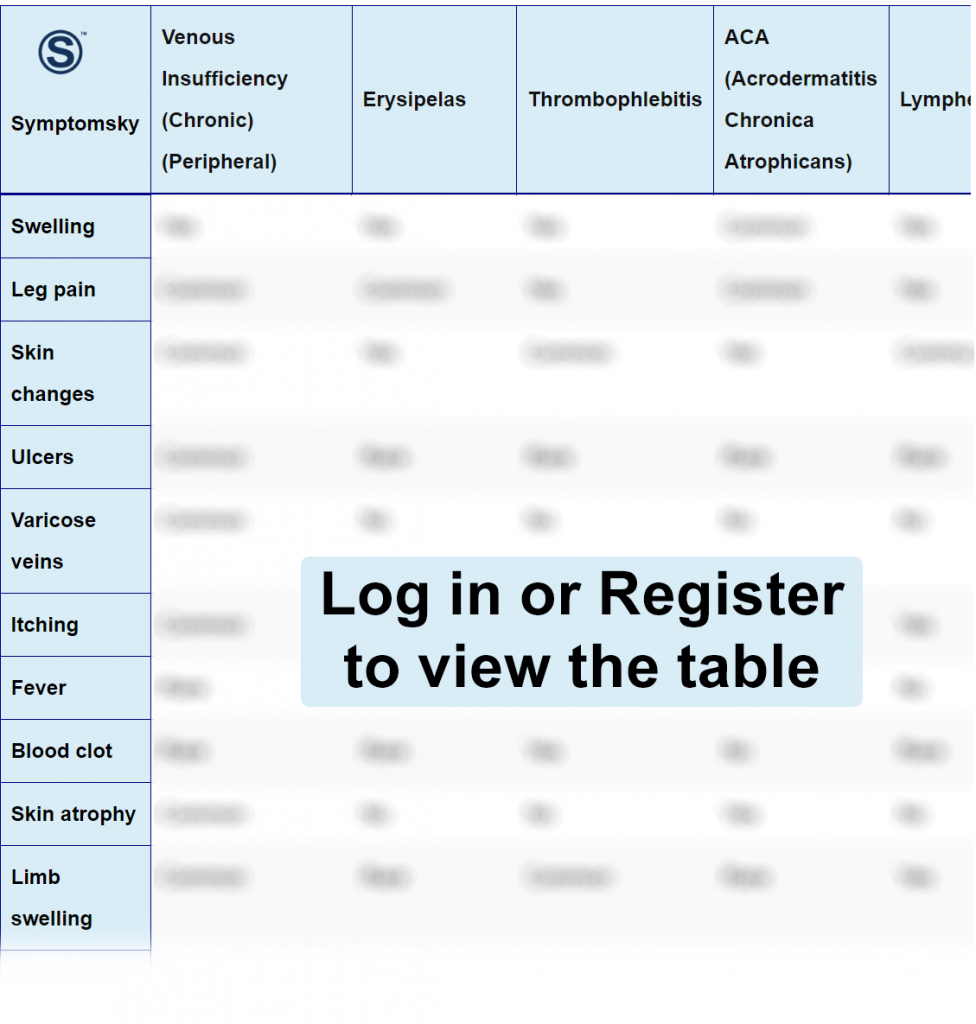Contents
- 1 Venous Insufficiency Differential Diagnosis Table:
- 2 Distinguish Venous Insufficiency from Other Diseases
- 2.1 Distinguish Erysipelas from Venous Insufficiency – Diagnosis
- 2.2 Distinguish Thrombophlebitis from Venous Insufficiency – Diagnosis
- 2.3 Distinguish ACA from Venous Insufficiency – Diagnosis
- 2.4 Distinguish Lymphedema from Venous Insufficiency – Diagnosis
- 2.5 Distinguish DVT from Venous Insufficiency – Diagnosis
- 2.6 Distinguish Cellulitis from Venous Insufficiency – Diagnosis
- 2.7 Distinguish Lipodermatosclerosis from Venous Insufficiency – Diagnosis
- 2.8 Distinguish Peripheral Neuropathy from Venous Insufficiency – Diagnosis
- 2.9 Distinguish Venous Stasis Dermatitis from Venous Insufficiency – Diagnosis
- 2.10 Distinguish Atherosclerosis from Venous Insufficiency – Diagnosis
- 3 Common Red Flag with Venous Insufficiency (Chronic) (Peripheral)
Venous Insufficiency Differential Diagnosis Table:

Chronic venous insufficiency is a disorder that disrupts the circulation in the extremities by vein blockage or valve disruption, resulting in blood pooling in the legs rather than flowing back to the heart.
Symptoms usually do not develop in the initial stages of the disease and appear as the disease advances. Typically, in the later stages, such patients present with pitting edema, swelling in legs and ankles, pain, fatigue, and itching on legs. Venous ulceration followed by atrophy (atrophie blanche) appears in the most advanced stages.
Distinguish Venous Insufficiency from Other Diseases
Distinguish Erysipelas from Venous Insufficiency – Diagnosis
Erysipelas is a skin condition caused by streptococci that affects the dermis and dermal lymphatic vessels.
- Erysipelas, being a bacterial infection, produces symptoms such as fever, chills, shivering, and malaise, usually 2 days before the cutaneous signs appear. Since venous insufficiency is not an infection, these are not seen in these patients.
- When chronic venous insufficiency affects the legs, it produces a distinct pattern of swollen veins known as spider veins. It is not seen in erysipelas.
- Moreover, chronic venous insufficiency frequently produces varicose veins that induce pain and cramping. Erysipelas has nothing to do with them.
“On the clinical examination, for erysipelas, one can see well-demarcated, red-colored, and warm skin lesions with raised borders. On the other hand, venous insufficiency appears as generalized swelling, with spider or varicose veins. In the most advanced stages, leg ulceration is seen.”
Distinguish Thrombophlebitis from Venous Insufficiency – Diagnosis
Thrombophlebitis is a localized inflammation, typically in the legs, due to the blockage of one or more veins by a blood clot formation. The inflammation can be in the superficial vein near the surface (superficial thrombophlebitis) or the deep vein (deep vein thrombophlebitis).
- Chronic venous insufficiency is frequently associated with red-brownish hyperpigmentation typically around ankles. A very rare finding in thrombophlebitis.
- Thrombophlebitis has been reported to turn the affected skin texture thick and hard. However, the opposite is seen with chronic venous insufficiency which advances into atrophic skin, reducing the dermal and epidermal thickness.
- Due to the varicose veins, people complain about their legs feeling uncomfortable and heavy. This is not true with thrombophlebitis.
“On palpation, thrombophlebitis feels like a cord under the skin, while the varicose veins are softer.”
Distinguish ACA from Venous Insufficiency – Diagnosis
ACA or acrodermatitis chronica atrophicans is a Lyme disease dermatological manifestation in its late stages. This disease usually develops in two stages, the inflammatory stage (swelling and redness of the skin) and the atrophic stage (atrophy of the affected skin). It most commonly affects the extremities, so it can be confused with venous insufficiency.
- In the early stage: both conditions appear almost similar. There is a red-colored itchy swelling, especially in the joint area like the ankle and knee. However, unlike chronic venous insufficiency, there are no varicose veins.
- In the late stage: the skin in the ACA appears very thin, shiny, hairless, and wrinkly, showing a characteristic “cigarette paper-like” appearance. This is not seen in venous insufficiency cases. Also, in this stage, the ACA lesion turns bluish in color, unlike the venous insufficiency lesion which is red-brown in color.
- ACA disease frequently damages the peripheral nervous system producing symptoms like numbness and tingling. This never occurs in venous insufficiency.
Distinguish Lymphedema from Venous Insufficiency – Diagnosis
Lymphedema is a disease that arises as a result of lymph accumulation, which leads to tissue and dermal changes, producing swelling.
- Lymphedema-associated swelling is usually generalized, affecting the entire limb and foot. On the contrary, chronic venous insufficiency usually produces swelling in the lower leg and ankles.
- The swelling associated with chronic venous insufficiency worsens during the day and gets better while resting. Lymphedema remains the same throughout the day.
Distinguish DVT from Venous Insufficiency – Diagnosis
Deep venous thrombosis occurs when a clot forms in any of the deep veins of the body, disrupting the venous return to the heart.
- Deep venous thrombosis produces swelling just like venous insufficiency. But unlike venous insufficiency, deep venous thrombosis produces swelling that is accompanied by erythema.
- Moreover, venous insufficiency causes skin discoloration red-brown in color, while deep venous thrombosis also produces red discoloration but it can turn blue in advanced cases.
- The typically present varicose veins in venous insufficiency never arise in deep venous thrombosis.
“During clinical examination, Homans sign is positive for deep venous thrombosis due to the presence of thrombosis but not for venous insufficiency.
Distinguish Cellulitis from Venous Insufficiency – Diagnosis
Cellulitis is an acute bacterial infection of the dermis and subcutaneous tissue that can affect the lower extremities.
- Since cellulitis is a bacterial infection, it usually produces fever, malaise, and chills that can never occur in venous insufficiency.
- Unlike venous insufficiency, the dermal changes in cellulitis can make the skin temperature feel warm and the texture orange peel-like.
- Evidence suggests that sometimes pustules and boils (with or without purulent discharge) can be seen in cellulitis. This can never be found in venous insufficiency.
- Moreover, cellulitis can also be accompanied by lymphadenopathy, which is rarely found in venous insufficiency.
“Cellulitis responds well to antibiotic therapy, while venous insufficiency won’t since it’s not a bacterial disease.
Distinguish Lipodermatosclerosis from Venous Insufficiency – Diagnosis
Lipodermatosclerosis is a chronic inflammatory condition that is characterized by inflammation of the skin and connective tissue, especially of the lower extremities. It manifests itself very similarly to venous insufficiency, so it’s very difficult to distinguish the two.
- Lipodermatosclerosis is extensively involved with subcutaneous fibrosis, which results in skin hardening. Meanwhile, venous sufficiency is usually softer to palpate.
- Subcutaneous fibrosis also makes the leg look like an inverted bottle of champagne, which is not common in people with venous insufficiency.
Distinguish Peripheral Neuropathy from Venous Insufficiency – Diagnosis
Peripheral neuropathy refers to disorders of the peripheral nerves.
- This condition commonly produces a tingling and numbing sensation in the affected part. As there is no neural involvement in venous insufficiency, these are never seen in it.
- Like all other neural conditions, peripheral neuropathy causes muscle weakness, and loss of sensation can make it difficult to walk and maintain balance. That’s not the case with varicose veins.
- Moreover, limb swelling is a very rare finding in neuropathy, which is one of the most common symptoms of venous insufficiency.
Distinguish Venous Stasis Dermatitis from Venous Insufficiency – Diagnosis
Venous stasis dermatitis, also known as venous eczema, is a condition of poor venous return to the heart due to impaired valves of the veins, causing blood to pool in the legs; in the process, some blood leaks out under the skin.
- Due to the pooling of blood, sometimes small capillaries burst and produce a typical appearance known as cayenne pepper spots. It is characterized by orange-brown spots on the skin. They are seen in venous stasis dermatitis, not in venous insufficiency.
- Long-standing and severe cases of venous dermatitis cause the skin to become extremely dry, flaky, thick, and hardened, giving a cobblestone-like appearance. It is not present in venous insufficiency.
Distinguish Atherosclerosis from Venous Insufficiency – Diagnosis
Atherosclerosis is the disruption of blood flow from the heart to tissues and organs due to the presence of fat deposits in the arteries. It can produce symptoms in the legs.
- These people feel cramping pain in their legs while walking. People who have venous insufficiency also feel pain while walking, but the pain nature is more like pressure and heaviness due to the pooling of blood in their legs.
- The legs affected by atherosclerosis have numbness, which is uncommon in venous insufficiency.
“During the clinical examination, the affected leg shows abnormal or delayed pulses, audible bruit, delayed capillary refill, and low skin temperature in atherosclerosis patients.“
Common Red Flag with Venous Insufficiency (Chronic) (Peripheral)
Venous insufficiency is not a life-threatening condition; however, it reduces the quality of life by inducing discomfort and pain. Also, evidence suggests that the risk of developing a blood clot in patients with varicose veins is higher. Blood clots can lead to deep venous thrombosis, pulmonary, and cranial embolism, which can be fatal.
When signs of venous insufficiency are apparent, a prompt medical examination is advised. The first signs include heaviness, edema, and pressure sensation in the legs. This usually worsens during the daytime and improves by resting at night. Other signs include discoloration, ulceration, itchiness, and varicose veins.
